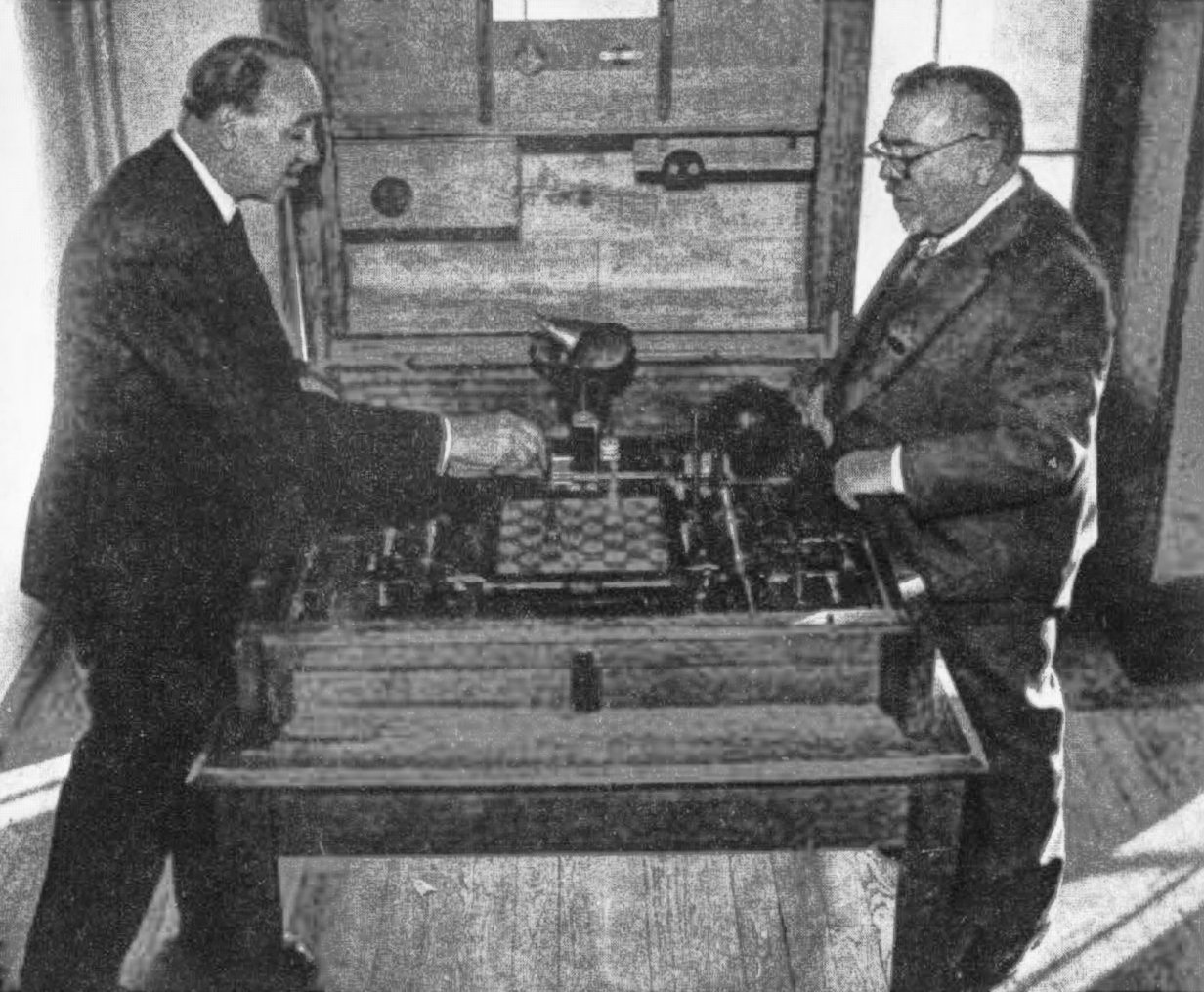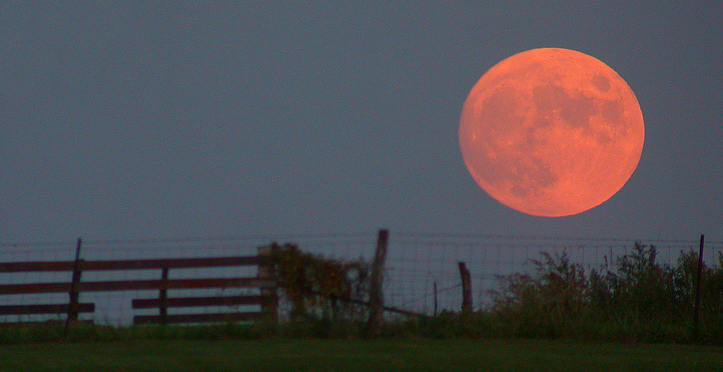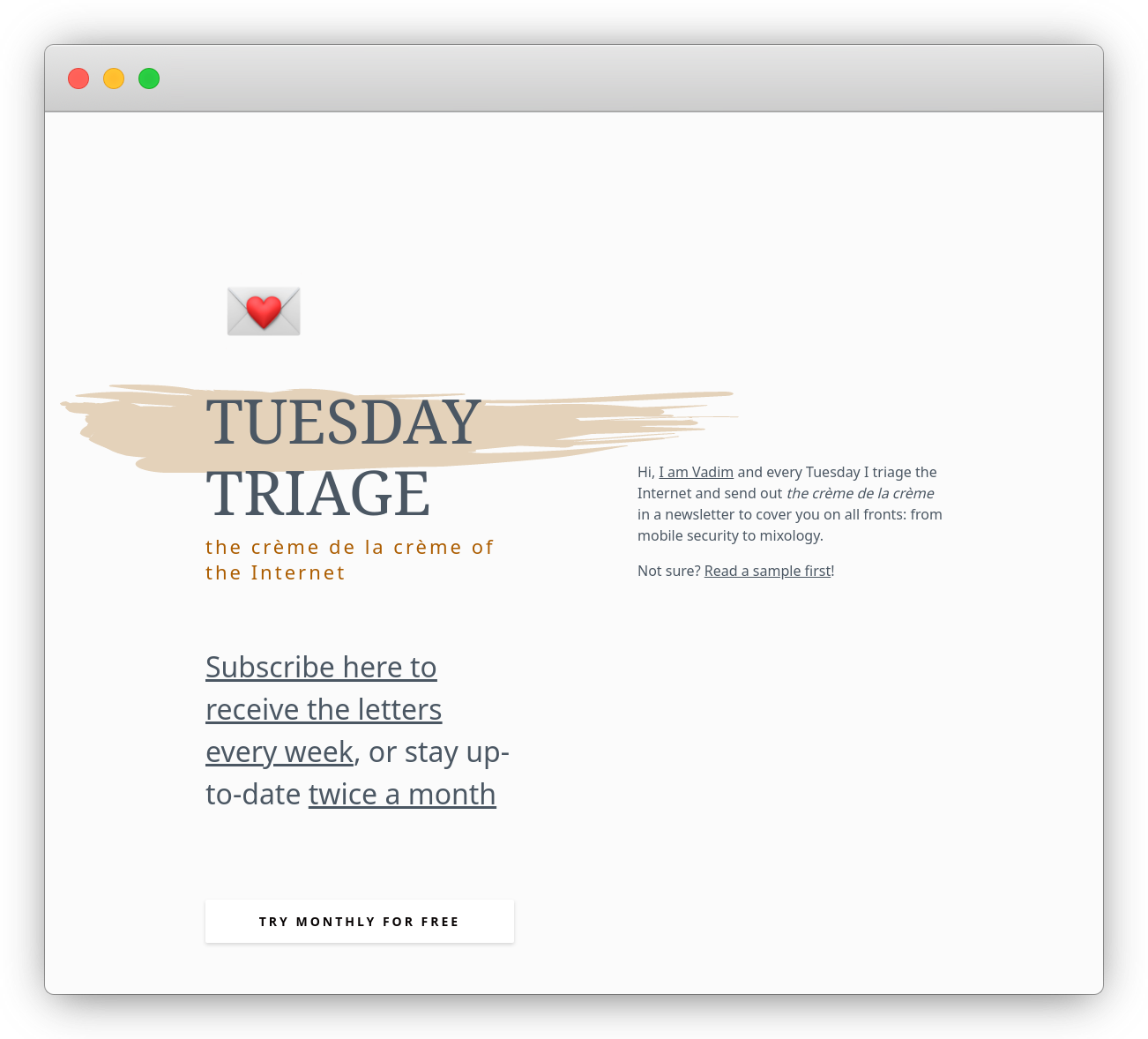Tuesday Triage #100
- TUESDAY TRIAGE #100 by Vadim Drobinin
- On a hundred newsletters
- Things I enjoyed reading
- 1. The six forces that fuel friendship by @julieebeck
- 2. Cooling the Tube by IanVisits
- 3. Generating true random numbers from bananas by @valerio_new
- 4. Not Just a Fence: The Story of a Stainless Steel Status Symbol by @anna_p_k
- 5. The business of kidnapping: inside the secret world of hostage negotiation by Joel Simon
- 6. Why Software Engineers like Woodworking by @zainrzv
- 7. The History of Vintage Steel Kitchen Cabinets by Pam Kueber
- 8. How Margaret Thatcher's secret Brahms phone was invented by Gordon Corera
- 9. The medical power of hypnosis by @Martha_Rosamund
- 10. What Trait Affects Income the Most? by Blair Fix
- Things I didn't know last Tuesday
- 1. Cacao mental
- 2. Black Velvet
- 3. Any tree could be a bonsai tree
- 4. El Ajedrecista
- 5. Bedale FC
- 6. Moon illusion
- 7. The flowing myth
- 8. Infantile amnesia
- 9. Encrypting secrets in music
- 10. Yesil Erik
- Book of the week
- Thank you and see you in a week
TUESDAY TRIAGE #100
by Vadim Drobinin ¶
Your weekly crème de la crème of the Internet is here!
14.06.2022 (read in browser)
-
Intro
Whatever is on my mind this week. -
Things I enjoyed reading
Ten-ish articles I found worth reading. -
Things I didn't know last Tuesday
Ten-ish facts I didn't know when I wrote the previous edition. -
Book of the week
Some thoughts on the latest book I've read.
On a hundred newsletters ¶
There is something particular about hundreds.
They feel more profound than dozens or multiples of five, but probably less so compared to thousands.
That being said, a hundred is a lot.
Here is to a hundred weeks of newsletters, probably a thousand hours of reading, filtering and writing, and then at least a thousand of articles from creators all over the world, and more than a thousand of things I (and probably you) didn't know nearly two years ago.
This is also hundreds of subscribers, surprisingly high open and click rates (50%+ and 20%+ respectively), and lots of appreciating from me given that the first editions were (and still are) merely a way to lure my wife into reading the articles I enjoyed.
I do tend to use anniversaries as an excuse for looking forward though, rather than counting characters in the past, and this one seems like a good opportunity to outline the plan for the next hundred of newsletters.
Here it is:
The amount of subscribers and the volume of emails I send weekly exceeded all my humble expectations, and to make it at least somehow sustainable I am introducing a few paid options, with a monthly edition staying free for everyone.
If you'd like to support the newsletter, please choose between weekly or bi-weekly plans (use code 100EDITION to get the first month for free).
Otherwise you will keep receiving the letters on a monthly cadence – no need to do anything to opt-in.
Thank you for staying with me for so long.
And now, without further ado, the 100th edition.
Things I enjoyed reading ¶
1. The six forces that fuel friendship by @julieebeck ¶
Even though I might come across as a rather asocial person to many, that's mostly a way to save time for both parties involved and avoid the chitchat. The same often applies to my attitude towards friends: we might hardly interact for years, but then eventually meet and spend hours or days talking, just because our paths intersected again.
Most friendships require a bit of courtship to get going. And even when they do seemingly fall in our lap—say, you get stuck on a sailboat in the Atlantic with nothing to do but socialize with your fellow sailors—they won’t grow without intention. This is the hardest part of friendship. It takes energy and thought, and our mental and physical resources are often spread thin. In other words, friendships take work. But I have never liked framing our friendships as labor. Showing up for our friends takes effort, yes, but it shouldn’t be drudgery. It should be a joy.
This is a very good take on the same topic: friendship shouldn't be a labour, and as it requires effort to create and maintain, we should choose very wisely.
2. Cooling the Tube by IanVisits ¶
Being blessed with work from home, I thought I forgot how bad is the Tube in summer. But then we hit the Central line in the middle of a weekend and I instantly remembered.
Over the years, the heat from the trains soaked into the clay to the point where it can no longer absorb any more heat. Tunnels that were a mere 14 degrees Celsius in the 1900s can now have air temperatures as high as 30 degrees Celsius on parts of the tube network.
What's odd is that a hundred years ago people used to go to the Tube to avoid the heat and that's reflected in the ads of that time. Nowadays buses are so much better.
3. Generating true random numbers from bananas by @valerio_new ¶
If I were to choose one exciting topic to explain to someone far from engineering, I would probably go for the game theory or rant about pseudo random numbers.
This is about the latter but from the more positive perspective of how could we fix it ourselves:
The possible way using bananas is that of radioactive decay. Bananas in fact are known to contain a lot of potassium, and a small but significant percentage of the potassium present in nature is radioactive. Specifically we are talking about the 40K isotope, which makes up 0.01% of potassium in nature. Plus they’re delicious with lemon and sugar, which alone would be a great reason to always have one on hand.
Now I know that next time I need a true random number I need to ditch the Yarrow algorithm and grab a banana.
4. Not Just a Fence: The Story of a Stainless Steel Status Symbol by @anna_p_k ¶
I never thought of it but it's hard to find a stainless steel fence here in the UK. Apparently across the pond this is way more common:
But the steel fence is not muted or uniform; it twists and turns to the taste of the maker, personalized with various ornaments, including lotus flowers, “om” symbols and geometric patterns. At night, street lamps and car headlights exaggerate the glimmer of stainless steel that does not, cannot disappear into the darkness like wrought iron. Whereas some people might be turned off by the flashiness, standing out is exactly its point — the stainless steel fence is an undeniable signal that the homeowner has arrived.
I wonder what are the status symbols here then, besides the honorific titles?
5. The business of kidnapping: inside the secret world of hostage negotiation by Joel Simon ¶
A story about the complexity of insurance business in the world where people could be kidnapped: if the insurance exists, that might prompt the kidnappers to act, but if it doesn't then there would definitely be a huge demand for it.
In 1986, the issue of K&R insurance was debated in parliament, which passed a motion expressing concern. There was even talk of working through European institutions to impose a ban on K&R insurance throughout the European Union. Recognising that its existence was under threat, the security industry rallied, arguing that since the policies were kept secret, it was clear that people were not being kidnapped because they had insurance. Rather, they were being taken hostage because they had resources – and banning insurance would not change this.
That probably means there are similar insurance policies for viruses and malware – I wonder how they find their audience.
6. Why Software Engineers like Woodworking by @zainrzv ¶
The last time I did some proper woodworking was probably fifteen or so years ago at school, but the more I visit modern restaurants the more I learn to appreciate hand-made and rustic butter knives and what not.
Now I know that if I were decided to make my own, the software engineering experience will help me out.
Any limited resource needs to carefully doled out. With software, the budgets might cover hardware constraints (CPU/memory), networking bandwidth, latency targets, engineering man-hours, etc.
Turns out, there's one inflexible budget with woodworking: Physical space!
In that sense cooking is similar to software engineering as well. Once you get a vacuum chamber, you start looking for a space for a PacoJet and it keeps going down the rabbit hole.
7. The History of Vintage Steel Kitchen Cabinets by Pam Kueber ¶
And on the topic of kitchen space, I am quite used to taking kitchen cabinets for granted (maybe because that's one of the deal breakers when we are looking for a flat to rent). As it seems, they went through a plenty of changes over the years:
The history of postwar steel kitchen cabinets in fact starts decades before. I’ve spotted “hoosier cabinets” from as early as the 1920s that were made of steel. These were promoted as “vermin proof.” Cleanliness was a big concern for homemakers in earlier parts of American history. For example, the whole notion of “Sanitary Kitchens” was very important. Remember, we had no vaccine for polio, for example, until the mid-50s, and the flu epidemic in 1914-1918 killed 450,000 people in the U.S. and up to 70 million worldwide. Rats and mice could not eat through steel [...]
I wouldn't mind a steel cabinet though (and a walk-in freezer too) but that's a story for a separate rant.
8. How Margaret Thatcher's secret Brahms phone was invented by Gordon Corera ¶
I think I've seen one of these devices at a science museum in Manchester, but didn't really pay much attention to its history: this is a nice write up.
Mike was made a temporary Queen's messenger with two seats on a flight to Geneva - one for him and one for the machine. He was told he would be met with a man carrying a brown envelope on arrival.
As he arrived at the castle, he was offered a gun. He declined.
Reads like a chapter from a James Bond memoirs too (if there were any).
9. The medical power of hypnosis by @Martha_Rosamund ¶
This is probably the first time I encounter a long read about hypnosis from the relatively academic point of view (altough "academic" is a word probably too powerful for a sequence of experiments).
The tests I responded to strongly (the heavy weight in my outstretched hand and the force pushing my hands apart) are the ones that will work for most people. In the heavy weight test, around 90% of the population will feel something, says Terhune – even he does, and he's a "low".
I wonder if these days there is a simple way to try those tests out remotely, maybe with a set of pre-recorded videos or using a VR headset (because if the latter works, it might a well open up a bunch of possibilities for a new generation of games).
10. What Trait Affects Income the Most? by Blair Fix ¶
This is an interesting research into traits and their correlation with income (mostly in the States). Obviously as with any attempt to correlate tomatoes and apples, take it with a pinch of salt:
The US evidence confirms this expectation. The 6 traits with the largest effect on income are all social. And social traits are the only ones to cross the one-to-one threshold in our signal-to-noise indicator. In other words, they’re the only traits that have a ‘large’ effect on income.
The social part of most traits (not age or gender, although they play a role too) circles us back to the very first article of the week: indeed, the majority of my most successful contracts were referrals from friends.
Things I didn't know last Tuesday ¶
1. Cacao mental ¶
There is a beautiful way to define a state of mental confusion in Spanish:
cacao mental (informal)
mental confusion
In Russian it'd be "каша в голове" (porridge inside one's head) – I'd probably prefer the cacao any time of the day.
2. Black Velvet ¶
Someone mentioned that the queen's mother used to enjoy beer but to make it more appropriate for a monarch had to mix it with Champagne in some ridiculous ratio (like 1:9 or something).
I couldn't find a proof for it though, but came across another somehow related beer cocktail:
The drink was first made by a bartender of Brooks's Club in London in 1861 to mourn the death of Prince Albert, Queen Victoria's Prince Consort. It is supposed to symbolize the black armbands worn by mourners. It was said that “even the champagne should be in mourning.”

It looks quite good, although probably not as tasty as the Death in the Afternoon (essentially absinthe and Champagne)
3. Any tree could be a bonsai tree ¶
That's not the first time I write about a bonsai tree, but it never occurred to me that these are not a species of small trees, these are just trees.
It is often though that Bonsai is a species of tree. This is not true. In fact bonsai is a method of growing trees which aims to create an image of a large mature tree but in miniature. So, you can create a bonsai Oak tree for example, by taking an existing Oak tree and styling it as a bonsai.
Now I just want a fir bonsai on my desk.
4. El Ajedrecista ¶
Most attempts at creating a chess playing machine in the late 19th or early 20th centuries were in fact humans playing from boxes – smoke and mirrors in its original form – but apparently there was at least one device capable of a somewhat conscious decisions.
El Ajedrecista (English: The Chess Player) is an automaton built in 1912 by Leonardo Torres y Quevedo in Madrid, one of the first autonomous machines capable of playing chess. As opposed to the human-operated The Turk and Ajeeb, El Ajedrecista was a true automaton built to play chess without human guidance. It played an endgame with three chess pieces, automatically moving a white king and a rook to checkmate the black king moved by a human opponent.

It even could signal illegal moves by an opponent – how cool is that?
5. Bedale FC ¶
There is this football club in North Yorkshire that signed a deal with Heck (they mostly make sausages in the UK) and as the result their uniform is hilariously good.
Another sausage-based uniform, the kit sported a hotdog pattern with Ketchup and Mustard running down the length of the sausage in the centre.

My favourite one is in the top left corner, as that year Heck went all vegan.
6. Moon illusion ¶
Tonight is the Full Super Moon, so it should appear 14% bigger and 30% brighter than usually at around 1 am UK time. This, however, is because of its location. The moon illusion is a purely driven by an optical perception:
The Moon illusion is an optical illusion which causes the Moon to appear larger near the horizon than it does higher up in the sky.

What's interesting is that there seem to be only possible explanations to the reasons behind it.
7. The flowing myth ¶
And speaking about possible explanations, apparently despite using glass for thousands of years we are not yet sure about a plenty of its properties:
In truth, no-one can say precisely when a liquid stops being a liquid and starts being a glass. Conventionally, physicists say a liquid has become a glass when the atomic relaxation – the time for an atom or molecule to move a significant portion of its diameter – is longer than 100 seconds.
One one hand, that means warped glasses in churches are likely mistakes of their creators. On the other hand, no one did a thousand-year expriment to check.
8. Infantile amnesia ¶
I hardly recall my earliest memories: the ones that I do most likely are creations of my imagination based on stories of my relatives (I don't have another explanation for why do I remember drinking some purple coloured lemonade when I was 11 months old).
Despite the fact that people can’t remember much before the age of 2 or 3, research suggests that infants can form memories – just not the kinds of memories you tell about yourself. Within the first few days of life, infants can recall their own mother’s face and distinguish it from the face of a stranger. A few months later, infants can demonstrate that they remember lots of familiar faces by smiling most at the ones they see most often.
Probably one day we will learn how to access whatever the leftovers of those memories are.
9. Encrypting secrets in music ¶
A great idea and the story behind it: encrypting names and dates on music sheets and then bypassing Soviet security with flying colours.
Musical note names span the letters A to G, so they don’t provide a full alphabet of options on their own. To create the code, Goldberg assigned letters of the alphabet to notes in the chromatic scale, a 12-tone scale that includes semi-tones (sharps and flats) to expand the possibilities. In some examples, Goldberg wrote only in one musical range, known as treble clef. In others, she expanded the register to be able to encode more letters and added a bass clef to extend the range of the musical scale. These details and variations also added verisimilitude to her encoded music.
I am also surprised that some pieces actually could have been played and would sound OK-ish for a random sequence of notes.
10. Yesil Erik ¶
These days I am trying to make umeshu, a Japanese plum liquor, but as the right plums are hard to come by I learnt about their Turkish alternative which happened to have lots of history:
Fresh Plum or Green Plum is a spring fruit and comes usually in May and sold in push stalls in Aegean Turkey.

An unconventional advice but if you ever try them raw, sprinkled the plums with a bit of salt: that's really good.
Book of the week ¶
Do you know Julie Powell? If not, you might at least know Julia Child?
Anyway, the former is the author behind the book "Julie and Julia" (that also inspired a movie of the same name), where she is cooking recipes of the latter, all in one a year.
The movie turned out to be quite inspiring, even though Julia mentioned that Julie has done everything for the sake of publicity and never commented on the actual flavours she explored or skills she learnt.
While in the North, I found out that Julie Powell actually published another book, which looked interesting enough to read, but not enough to bring across the country, so I picked myself a digital copy of Cleaving: A Story of Marriage, Meat, and Obsession on the way back:
So, as I've mentioned, the hard part, or rather the frustrating part, with skirt steak is the trimming. The thick filament that makes the muscle easy to remove is also so thick as to be inedible, or at least not very fun to eat. It must be removed, but it doesn't want to go, and clings determinedly. Some of it you can peel off with your fingers in strips, which is satisfying, rather like peeling nail polish, if your fingernail was four inches wide and two feet long. But like nail polish, bits of it stick stubbornly. Peeling also gets dangerous because sometimes you pull up a lot of meat with it, and if this happens at a thin space in the muscle, the steak can tear right in two. This is where your knife comes in.
Right, so as I learnt rather soon, this book is more of a story of marriage and obsession, and not at all a story about butchery.
It starts with Julie finding a job as a butcher apprentice, and despite occasional recipes and lifehacks quickly spirals into a long blog post about her marriage, mutual affairs, and bad decisions.
Before reading, I've seen plenty reviewers complaining about too many gruesome details and thought that they just never butchered a cow.
Well, they didn't mean cows, they meant her personal life.
I can't really recommend the book, but at least you can join me in the knowing that it's not all kittens and rainbows after the success of "Julie and Julia".
Thank you and see you in a week ¶
##(or two, or a month)!
If you'd like to support the newsletter, please choose between weekly or bi-weekly plans. Otherwise you will keep receiving the letters on a monthly cadence – no need to do anything to opt-in.
If you have any questions, or want to suggest a link for the next newsletter, please drop me a message on Twitter or reply to this email.
Cheers! 🍸
